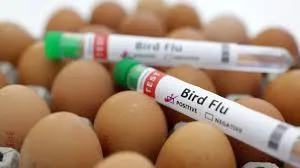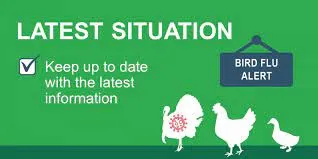Bird Flu Strikes Commercial US Poultry- “Discover the latest on the resurgence of bird flu in the US poultry industry. Learn about its impact, preventative measures, and the economic challenges faced by farmers. Stay informed!”
Bird Flu Strikes Commercial US Poultry Introduction
In a distressing turn of events, the United States’ poultry industry is grappling with a resurgence of avian influenza, commonly known as bird flu. This highly contagious virus has resurfaced, infecting commercial poultry flocks, and sending shockwaves through the industry. After a brief reprieve since April, the outbreak has reared its ugly head, posing significant challenges to poultry farmers, consumers, and the economy at large.
In this comprehensive article, we will delve into the resurgence of bird flu in the United States, its impact on the poultry sector, and the measures being taken to mitigate its spread.

Understanding Bird Flu
Bird flu, or avian influenza, is a highly contagious viral infection that primarily affects birds. However, it can occasionally spill over to infect humans and other animals. The virus is categorized into various strains, with some posing more significant risks than others. In recent years, the H5N1 and H7N9 strains have garnered particular attention due to their potential to cause severe illness in humans.
The Recent Outbreak
The recent outbreak of bird flu marks a grim milestone for the United States. Since April, when the last reported case was documented, the industry had been hoping for a reprieve. Unfortunately, this hope was dashed when a commercial poultry flock tested positive for the virus, signaling its return.
The infected flock was located in a poultry farm in the heart of a major poultry-producing state. The discovery sent shockwaves through the industry, prompting immediate action from health officials and farmers alike.
Impact on the Poultry Industry
The resurgence of bird flu is not only a threat to the affected birds but also to the entire poultry industry. The consequences are far-reaching and multifaceted.
Economic Impact
The outbreak has led to the culling of infected birds and those at risk of infection, resulting in significant financial losses for poultry farmers.
Reduced production and increased costs of disease management are expected to lead to higher poultry prices for consumers.
Trade Restrictions
Several countries have imposed bans on imports of U.S. poultry products to prevent the potential spread of the virus, further affecting the industry’s revenue.

Emotional Toll
Poultry farmers are facing immense stress and emotional distress due to the loss of their flocks and the uncertainty surrounding their livelihoods.
Bird Flu Strikes Commercial US Poultry Preventative Measures
In response to the resurgence of bird flu, both federal and state authorities, in collaboration with poultry industry stakeholders, have implemented a series of preventive measures:-
Enhanced Biosecurity: Farms are bolstering biosecurity measures to minimize the risk of disease transmission, including restricted access, disinfection protocols, and increased monitoring.
Vaccination Campaigns: Some states are initiating mass vaccination campaigns for poultry, aiming to build immunity against the virus.
Surveillance and Rapid Response: Early detection and immediate culling of infected birds are crucial in preventing further outbreaks.
Q1: Can bird flu infect humans?
Yes, while it primarily affects birds, certain strains of bird flu, such as H5N1 and H7N9, can infect humans. However, human-to-human transmission is rare.
Q2: How is bird flu transmitted?
Bird flu is primarily transmitted through contact with infected birds or their droppings. It can also spread through contaminated surfaces and equipment.
Q3: What are the symptoms of bird flu in humans?
Symptoms in humans can range from mild to severe and may include fever, cough, sore throat, and difficulty breathing. Severe cases can lead to pneumonia and even death.
Bird Flu Strikes Commercial US Poultry Conclusion
The resurgence of bird flu in the United States poses a significant challenge to the poultry industry, with far-reaching economic and emotional consequences. Swift and coordinated efforts by authorities and industry stakeholders are crucial to containing the outbreak and preventing further damage.
As consumers, it’s essential to stay informed about the situation and support local poultry farmers during these challenging times. With effective measures in place, there is hope that the poultry industry will weather this storm and emerge stronger.










